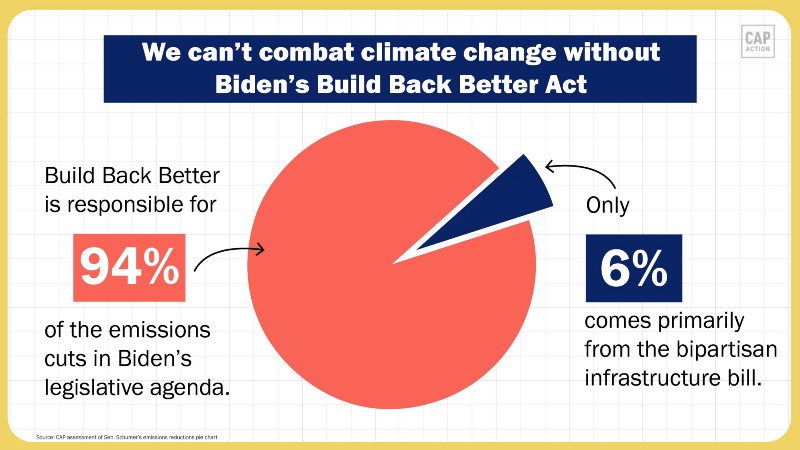Passing the Infrastructure Investment and Jobs Act alone, without the Build Back Better Act, is not climate action.
In fact, ignoring our planet’s future while considering infrastructure investments is playing into the hands of corrupt fossil fuel interests. This past July, an ExxonMobil lobbyist was exposed specifically outlining their strategy to get Congress to “stick to highways and bridges” in the infrastructure package in order to sideline climate action.
To avoid the worst impacts of the climate crisis, the U.S. must reach net-zero economy-wide greenhouse gas emissions no later than 2050. By cutting greenhouse gas emissions to as much as 45 percent below 2005 levels by 2030, with more state and regulatory action to follow, the combination of infrastructure and reconciliation legislation will put us on the path that science demands. But the two pieces of legislation — the Infrastructure Investment and Jobs Act (IIJA), and the Build Back Better Act — are not equal.
Of the emissions reductions that Senate Majority Leader Charles Schumer recently estimated could result from the combined reconciliation and infrastructure agenda, roughly 94 percent come from investment categories that are primarily made through the Build Back Better Act; only three categories of investment worth just 6 percent of the emissions reductions are primarily made through the IIJA. That equates to approximately one-tenth of a gigaton of annual emissions reduction, comparable to the average annual emissions reduction projected for the Trump administration’s final spending deal. Even this estimate is generous, as it neglects the negative effects of the investments the bill also makes in highways and fossil fuels.

The planned investments from the combination of the IIJA and the Build Back Better Act were estimated by Majority Leader Schumer to cut U.S. greenhouse gas emissions to as low as 45 percent below 2005 levels by 2030, which with anticipated regulatory action is consistent with President Biden’s science-based goal of 50 to 52 percent below 2005 levels by 2030. The share of emissions reductions attributable to each investment category was reported in a pie chart totaling 100 percent.
Out of the categories included in the pie chart, 94 percent of the emissions reductions delivered by President Biden’s combined infrastructure and reconciliation agenda would primarily come from the investments made in the Build Back Better Act. Specifically, these investments are represented by the following pie chart categories: coastal resilience, a clean energy and sustainability accelerator, rural co-op clean energy support, fossil fuel subsidy repeals, clean fuel tax incentives, clean building incentives, agricultural conservation and forest management, a methane fee, clean vehicle incentives, a clean electricity payment program, and clean energy tax incentives.
Only three of the categories in the pie chart are primarily invested in through the IIJA: transit electrification and ridership increase, industrial decarbonization demonstration projects, and cleaning up abandoned mines and wells. Together, these three categories represent just 6.4 percent of the emissions reductions. The effects of the bill’s spending on highways, fossil fuel buses, and fossil fuel refueling stations are not evaluated.